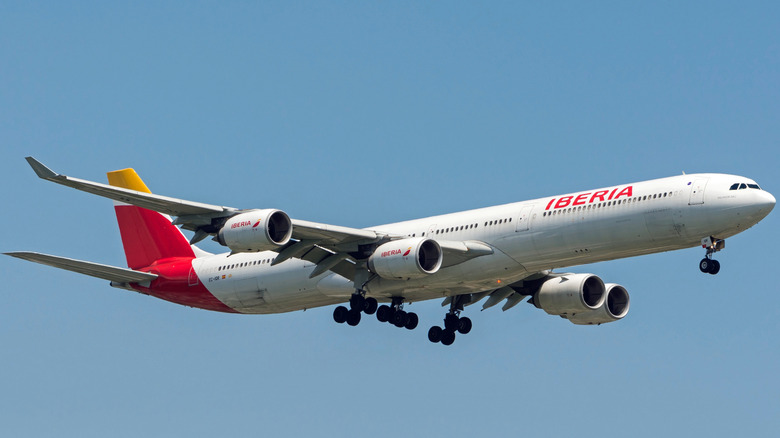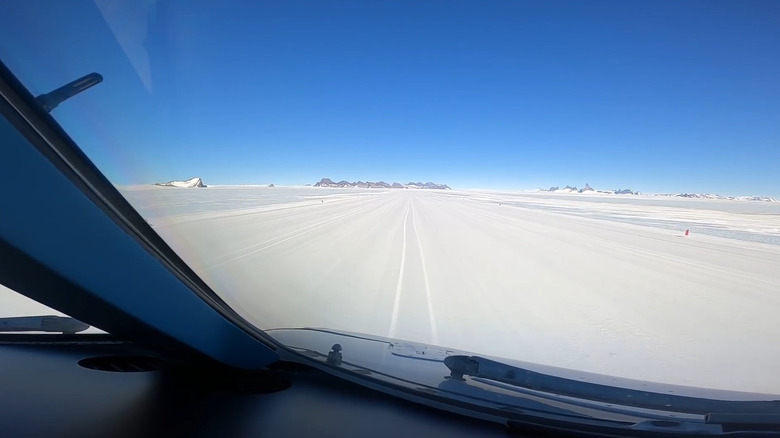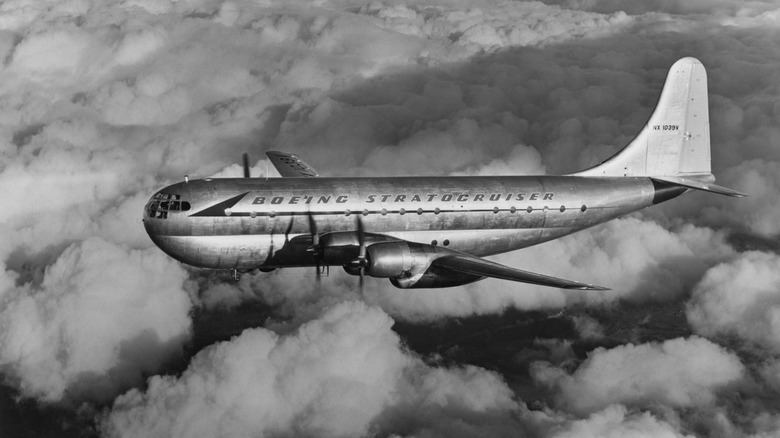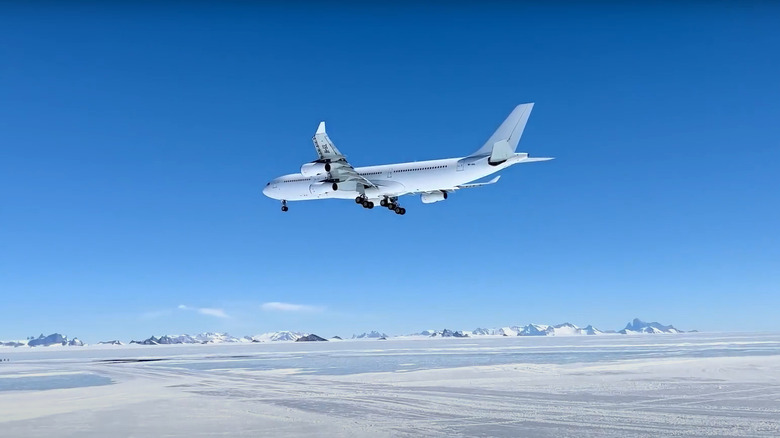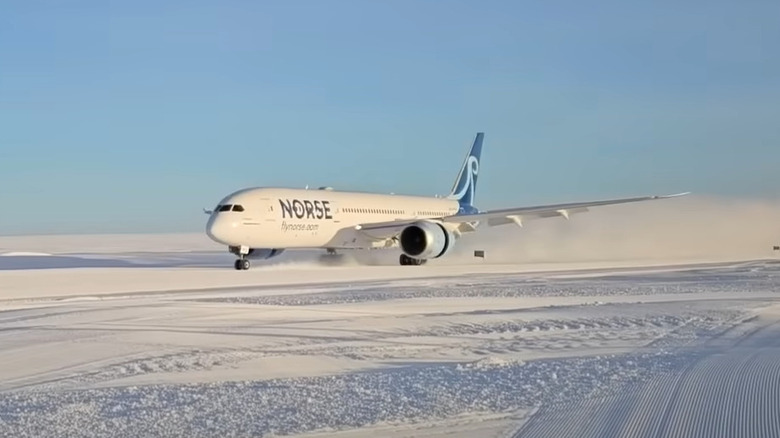Can Commercial Planes Land On Ice?
There are a few things you can do to stay safe while traveling in inclement weather, but driving on an icy road is probably not a risk everyone is eager to take. Now, imagine landing a plane on an icy runway — how difficult would that be? Landing on ice is indeed a serious challenge, even for highly experienced pilots.
Pilots often have to land on icy runways in parts of Russia and Canada, Antarctica, and in some Scandinavian countries. When you add wind, precipitation, and freezing temperatures to the mix, it becomes clear why landing on ice demands extensive preparation and expertise. Some military aircraft are built to operate in extreme conditions, and can land on ice – Lockheed Martin's C-130 Hercules has been used for missions in places like Antarctica.
What about commercial planes, though? Can they land on ice? The short answer is "yes," but landing on ice requires thorough planning and careful execution. Here's what you need to know.
Why it's difficult to land on ice
Landing on ice is difficult primarily because planes may struggle to decelerate effectively and maintain directional control. According to the Federal Aviation Administration (FAA), a runway is contaminated "when more than 25 percent of the runway surface area (within the reported length and the width being used) is covered by frost, ice, and any depth of snow, slush, or water."
Here's what that means.
Solid ice, snow with a depth greater than 3 mm (1/8 of an inch), and water deeper than 3 mm can make a runway contaminated. Compacted snow can have the same effect – if the temperature is below -15 degrees Celsius (5 degrees Fahrenheit), the runway is considered safe, but may be deemed unsafe if the temperature rises above that.
As retired airline captain John Cox explained for USA Today, "Pilots listen carefully to other landing airplanes for descriptions of the stopping ability on the runway. Runway conditions can change quickly, requiring judgment and experience by the pilot to determine whether it is safe to proceed."
Technological advancements have also made pilots' lives easier, according to Cox, who noted that the anti-skid braking system on modern planes makes all the difference when it comes to landing on ice.
Pioneering flights to Antarctica
On October 31, 1956, a U.S. Navy R4D Skytrain, nicknamed "Que Sera Sera," landed at the South Pole. This monumental achievement had a significant impact on future developments in aircraft technology, particularly operations in remote locations like Antarctica.
Another historic event took place a year later, when "Clipper America" — a Boeing 377 Stratocruiser — did the same. Operated by Pan American World Airways, the commercial aircraft flew from Quonset Point, Rhode Island, to San Francisco, California, then to Honolulu, Hawaii, and on to Christchurch, New Zealand. From Christchurch, the plane flew to Ross Island in McMurdo Sound and landed there safely.
While "Clipper America" lacked many of the capabilities of modern Boeing passenger jets and commercial aircraft, its successful landing in Antarctica was a demonstration that commercial aircraft could operate in such extreme conditions. Flights to Antarctica are now not as uncommon as they once were, as evidenced by the two recent examples below.
When the Airbus A340 landed on Antarctica's blue ice
One recent notable example of a commercial plane landing on ice occurred in February 2021, when the South African charter company, Hi Fly, landed an Airbus A340 in Antarctica.
Captain Carlos Mirpuri and his crew flew the aircraft from Cape Town, South Africa, to Antarctica's blue glacial ice runway on November 2 that year.
"This is not just another flight, there are specificities related to this very remote operation we would be conducting, the harsh environment we would face, and the need to ensure proper protective clothing would be on board," Mirpuri wrote in his log, hoping the crew and the 23 passengers aboard land safely. "A blue glacial ice runway is hard. It can stand a heavy airplane on it. Its depth is 1,4 kms of hard air free ice. The next important thing is that the cooler it is the better," he added.
The flight went well, bar a minor hiccup with the digital communication system. Landing gear was fully stabilized 10 miles before the runway — which blended with its surrounding — and Mirpuri and his crew landed safely.
Norse Atlantic Airways replicated Hi Fly's success
Norwegian airline, Norse Atlantic Airways, replicated Hi Fly's success almost exactly two years later, on November 16, 2023.
The flight — conducted using a Boeing 787 Dreamliner – transported 45 scientists and 12 tons of research equipment from the Scandinavian country to Antarctica. In cooperation with the Norwegian Polar Institute and Aircontact, Norse Atlantic Airways began the journey from Oslo, had a 48-hour layover in Cape Town, and then flew to Antarctica, successfully landing on the same blue ice runway that Hi Fly's Airbus A340 had landed on two years earlier.
"It is a great honor and excitement on behalf of the entire team Norse that we have achieved together a momentous moment of landing the first 787 Dreamliner. In the spirit of exploration, we are proud to have a hand in this important and unique mission. It is a true testament to our highly trained and skilled pilots and crew and our state-of-the-art Boeing aircraft," the CEO of Norse Atlantic Airways, Bjørn Tore Larsen, said at the time.
In November 2024, Norse Atlantic Airways completed its second Dreamliner flight to Antarctica, proving once again that large commercial planes can land on ice.
